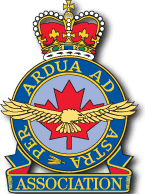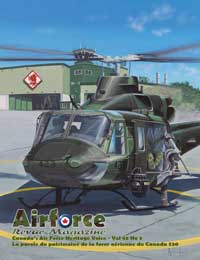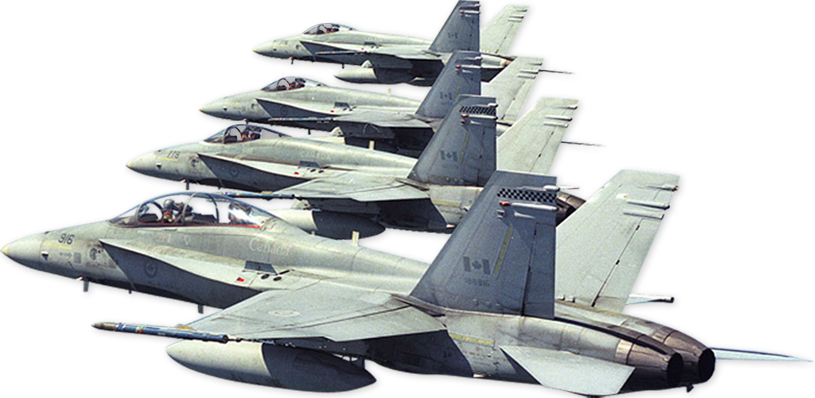 No. 403 Squadron
No. 403 Squadron
Badge: A wolfs head erased
Motto: Stalk and strike
Authority: King George VI, October 1943
The wolf is a fierce and powerful antagonist, indigenous to most parts of Canada.
Formed at Baginton, Warwickshire, England on 1 March 1941 as the first of 35 RCAF squadrons to be formed overseas – third Fighter squadron in service – the unit flew Spitfire air-craft on offensive and defensive air operations, and in support of Allied ground forces in North-West Europe. The squadron was disbanded at Fassberg, Germany on 10 July 1945.
Brief Chronology: Formed at Baginton, War., Eng. 1 Mar 41. Disbanded at Fassberg, Ger. 10 Jul 45.
Title or Nickname: “Wolf”
Adoption: City of Calgary, Alta.
Commanders
- S/L B.G. Morris (RAF) 6 Mar 41 – 21 Aug 42 POW.
- S/L R.A. Lee-Knight (RAF), DFC 23 Aug 41 – 27 Sep 41 KIA.
- S/L C.E. Gray (RAF), DFC and Bar 28 Sep 41 – 29 Sep 41.
- S/L A.G. Douglas (RAF), DFC 30 Sep 41 – 11 Jan 42.
- S/L C.N.S. Campbell (RAF), DFC 12 Jan 42 – 27 Apr 42 POW.
- S/L A.C. Deere (RAF), DFC and Bar 30 Apr 42 – 12 Aug 42.
- S/L L.S. Ford, DFC and Bar 13 Aug 42 – 21 Apr 43.
- S/L C.M. Magwood, DFC 22 Apr 43 – 12 Jun 43.
- S/L H.C. Godefroy, DFC and Bar 13 Jun 43 – 11 Aug 43.
- S/L W.A.G. Conrad, DFC 12 Aug 43 – 17 Aug 43 MIA. (Returned safely to Britain on 10 October 1943)
- S/L F.E. Grant 27 Aug 43 – 4 Sep 43 KIA.
- S/L N.R. Fowlow, DFC 5 Sep 43 – 5 Oct 43.
- S/L R.A. Buckham, DFC and Bar 6 Oct 43 – 14 Jun 44.
- S/L E.P. Wood, DFC 16 Jun 44 – 15 Nov 44.
- S/L J.E. Collier 26 Nov 44 – 15 Feb 45. (Credited with the RCAF’s first solo victory over a Me.262 jet on 25 December 1944 flying a Spitfire Mk. XVI SM338)
- S/L H.P.M. Zary, DFC 16 Feb 45 – 16 May 45.
- S/L A.E. Fleming 17 May 45 – 10 Jul 45.
Higher Formations and Squadron Locations
Fighter Command:
No. 9, Group,
- Baginton, War. 1 Mar 41 – 29 May 41.
- Ternhill, Salop. 30 May 41 – 3 Aug 41.
No. 11 Group,
- Hornchurch, Essex 4 Aug 41 – 14 Aug 41.
- Debden, Essex 25 Aug 41 – 2 Oct 41.
- Martlesharn Heath, Suffolk 3 Oct 41 – 21 Dec 41.
- North Weald, Essex 22 Dec 41 – 1 May 42.
- Southend, Essex 2 May 41 – 2 Jun 42.
- Martlesharn Heath, Suffolk 3 Jun 42 – 18 Jun 42.
No. 13 Group,
- Catterick, Yorks. 19 Jun 42 – 22 Jan 43.
- 4 aircraft, West Hartlepool, Durham 19 Jun 42 – 22 Jan 43.
No. 11 Group, Canadian Kenley Wing,
- Kenley, Surrey 23 Jan 43 – 4 Jul 43.
Second Tactical Air Force:
No. 83 (Composite) Group,
No. 17 (RCAF) Sector (disbanded 13 Jul 44).
No. 127 (RCAF) Wing,
- Kenley, Surrey 5 Jul 43 – 6 Aug 43.
- Lashenden, Kent 7 Aug 43 – 19 Aug 43.
- Headcorn, Kent 20 Aug 43 – 13 Oct 43.
- Kenley, Surrey 14 Oct 43 – 17 Apr 44.
No. 16 Armament Practice Camp, Hutton Cranswick, Yorks. 24-29 Feb 44.
- Tangrnere, Sussex 18 Apr 44 – 15 Jun 44.
- B.(Base) 2 Bazenville, Fr. 16 Jun 44 – 15 Aug 44.
- B.26 Illiers l’Eveque, Fr. 26 Aug 44 – 21 Sep 44.
- B.68 Le Culot, Bel. 22 Sep 44 – 30 Sep 44.
No. 11 Armament Practice Camp, Fairwood Common, S. Wales 22 Sep – 3 Oct 44.
- B.82 Grave, Neth. 1 Oct 44 – 20 Oct 44.
- B.58 Melsbroek, Bel. 21 Oct 44 – 2 Nov 44.
- B.56 Evere, Bel. 3 Nov 44 – 1 Mar 45.
Pilots to United Kingdom to re-equip with Spitfire XVJ’s 2-4 Dec 44.
No. 17 Armament Practice Camp, Warmwell, Dorset., Eng. 4-14 Jan 45.
- B.90 Petit-Brogel, Bel. 2 Mar 45 – 30 Mar 45.
- B.78 Eindhoven, Neth. 31 Mar 45 – 10 Apr 45.
- B.100 Goch, Ger. 11 Apr 45 – 27 Apr 45.
- B.152 Fassberg, Ger. 28 Apr 45 – 10 Jul 45.
Representative Aircraft (Unit Code KH)
Curtiss Tomahawk Mk.I & IIA (Mar – Jun 41)
- AK878 H
Supermarine Spitfire Mk.I (May – Jul 41)
- N3066 N P7129 A R6611 T R6984 F R7058 0 R7065 X R7066 E R7068 G R7140 D X4026 J X4319 M X4329 C X4674 R X4766 H X4856 L
Supermarine Spitfire Mk.HA (Jul – Sep 41)
- P7280 N P7352 B P7355 W P7368 J P7422 0 P7438 G P7505 C P7529 C P7552 Q P7622 M P7743 Q P7744 E P7746 K P7756 U P7776 S P7818 T P7905 P P7911 B P7915 W P7979 Z P8017 Z P8090 H P8171 A P8233 L
Supermarine Spitfire Mk.VB & VC (4-21 Aug 41)
- P7220 F P7235 C P7310 B P7342 A P7343 D P8740 E P8744 P P8792 Y R7260 T R7266 J R7273 L R7279 S W3114 R W3436 X W3438 G W3446 V W3453 M W3502 K W3573 K W3630 Z
Supermarine Spitfire Mk.VB (Sep 41 – Jan 43)
- P7438 G R6890 H W3170 V W3318 N W3426 D W3421 F W3564 K W3650 X W3822 Q W3823 S W3938 J AA834 B AA927 H AB190 Z AB364 U AB799 J AB865 T AB981 Z AD114 W AD191 W ADl 99 H AD206 R AD207 0 AD208 L
Supermarine Spitfire Mk.IX (Jan 43 – Feb 44)
- BS509 H MA575 P
Supermarine Spitfire Mk.IXB (Feb – Dec 44)
- MJ352 Q MJ355 H MJ480 R MK859 T
Supermarine Spitfire Mk.XVI (Dec 44 – Jul 45)
Operational History: First Mission 11 May 1941, 2 Tomahawks from Baginton – base patrol at 25,000 feet.
First Offensive Mission: 5 August 1941, 11 Spitfire VB’s from Hornchurch – low squadron of high cover wing for Blenheims bombing St Orner, France.
First Victory: 9 August 1941, 11 Spitfire VB’s from Hornchurch – target support wing for Blenheims bombing Gosnay. P/O K.H. Anthony in K3573 KH-K credited with a Bf.109F probably destroyed. 19 August 1941, 12 Spitfire VB’s from Hornchurch – dose-cover target support (independent wing) for 6 Blenheims bombing Gosnay, engaged 15 Bf.109’s. Squadron credited with 4 destroyed, 1 probable and 2 damaged for the loss of 2 Spitfires. (One pilot listed as missing in action; the other, P/O Anthony, rescued from the Channel.) S/L B.G. Morris (RAF), in K3438 KH-G, credited with 1 destroyed, 1 damaged.
Triple Victory: 2 July 1944, 12 Spitfire IXB’s from Bazenville – front line patrol east of Caen, France; encountered 20-plus Bf .109’s and credited with 9 destroyed, 3 damaged, without loss. F/L J.D. Lindsay leading a flight assigned to high cover; while climbing through cloud, engaged a second group of 15-plus Bf.109’s and credited with 3 destroyed.
Last Mission: 8 May 1945, 6 Spitfire XVI’s from Fassberg – escorted Dakotas to Copenhagen. Two of the Spitfires had mechanical trouble and landed at Kastrup.
Summary Sorties: 13,004 (29 on Tomahawks)
- Operational/Non-operational Flying Hours: 17,728/13,253.
- Victories:
- Aircraft: 123 (plus 7 shared) destroyed, 10 probably destroyed, 72 (plus 1 shared) damaged.
- Ground: dropped 70 tons of bombs, credited with 17 rail cuts; destroyed or damaged 50 locomotives, 150 freight cars, and almost 130 vehicles (including 30 armoured).
- Casualties:
- Operational: 85 aircraft; 76 pilots, of whom 4 were killed, 40 presumed dead, 21 POW (1 escaped, 2 died), 11 evaded capture.
- Non-operational: 19 personnel killed, 1 seriously injured.
Squadron Aces: F/L H.D. MacDonald, DFC and Bar 7½-1-2. F/L J.D. Lindsay, DFC 6½-0-5. S/L L.S. Ford, DFC and Bar 6-0-2. S/L H.C. Godefroy, DFC and Bar 5-0-1
Honours and Awards: 4 Bars to DFC, 16 DFC’s, 1 Military Medal (The only British Military Medal awarded to someone in the air force – all other BMMs were awarded to soldiers, being purposely awarded for ‘gallantry on the battlefield – Awarded to an American serving in the RCAF – Sgt. (Later P/O) Charles Edward McDonald, for escaping from POW camp. Sgt. McDonald returned to France with the aid of the Polish underground, and eventually to England. His escape to freedom came two years after being shot down. On escaping he made his way toward Auschwitz, where he is believed to have provided intelligence that confirmed suspicions about what was going on there. He died from his burns suffered in an F-86 crash while flying with the USAF near a Massachusetts airport, in the 1950s), 33 MiD’s.
Battle Honours:
- Defence of Britain 1941-1944.
- English Channel and North Sea 1942.
- Fortress Europe 1941-1944: Dieppe.
- France and Germany 1944-1945: Normandy 1944, Rhine.









